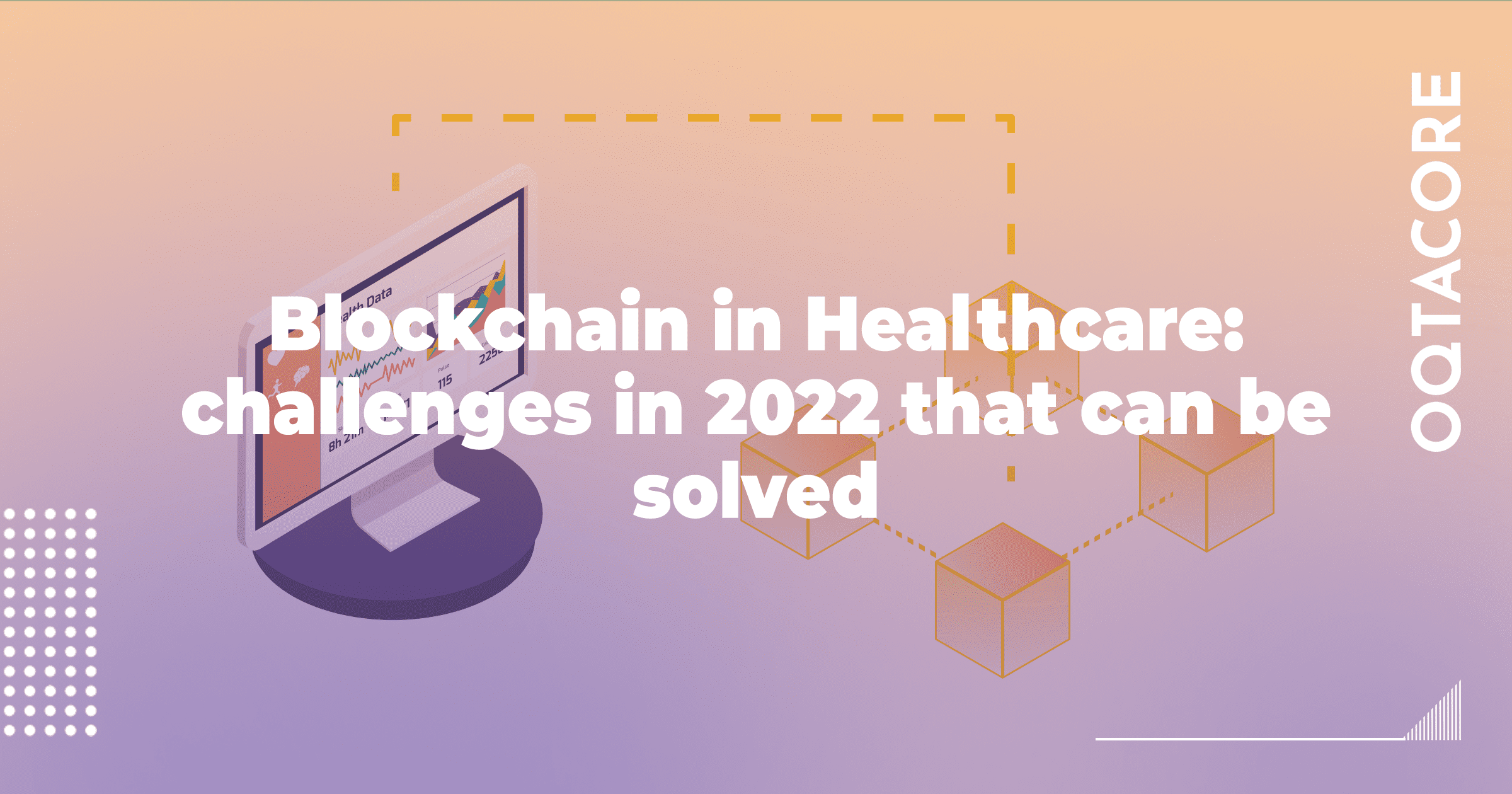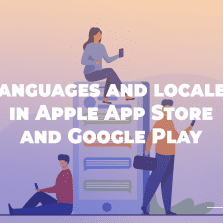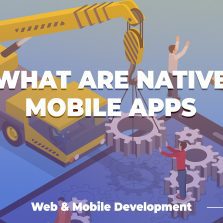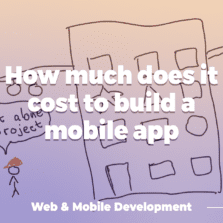
In our new blog post, OQTACORE will discuss how blockchain could be an innovative solution for medicine and healthcare around the world. We’ll also look at which healthcare challenges in 2022 can be tackled with blockchain, and which startups are adopting blockchain in healthcare.
Even before Covid-19, healthcare worldwide was facing problems that could not be solved with traditional technologies and the Internet. Among such issues were low compatibility of medical devices and software, lack of information accuracy and trust when sharing information, etc. However, things are gradually changing with the introduction of blockchain.
Let’s start with the blockchain technology itself, recalling basic concepts and terms.
Blockchain structure
Blockchain is a digital ledger that records and stores information in the form of a growing list of ordered records, called blocks. A blockchain consists of multiple data points or computers participating in the network, each storing a copy of the information. An individual computer in a blockchain network is called a node.
Because of information duplication, blockchain is called a trustless data storage system – each node has identical data, which means that its integrity and immutability are verified by computers among themselves, that is, without resort to any central authority or third party. Information verification and comparison between nodes is mandatory. This is the blockchain consensus algorithm.
Verification is structured as follows: each node in a blockchain network has a pair of keys:
- Public key is the node address, which allows it to request information for sharing.
- Private key is stored by the network owner and is required to confirm data sharing.
When node A stores information in the blockchain, it signs it with its private key. Then the information is passed to node B, which checks it against the previous information in the blockchain and adds it to the block of its local blockchain copy. So, when new blocks are received, node B will match the data with the information it approved and made part of its local copy.
It turns out that each of the nodes must have its own local copy of the ledger to work correctly. How do nodes decide who has the most correct information? It depends on the rules of the blockchain network. For example, the simplest rule is that the longest chain is the reliable one and nodes copy it in their local version . There may also be block requirements; for example, only one node is allowed to build a chain – all other nodes must copy updates only from it.
In the network, any data that has been verified and added to a block cannot be altered or deleted. This is the main blockchain feature. Each block has a unique set of characters, a hash, which is transformed information and a digital “fingerprint”. The network uses it to track any attempt to change information: if you delete or alter even one character of the original message, the hash value will also change, and it will be a different block of information. Moreover, it is infeasible to find two different messages with the same hash value (more precisely, you can, but the probability of this event is 10-23 or lower). Due to the cryptographic hash function, the data in the recorded block cannot be altered without breaking the correctness of the chain.
Thanks to the hash function, the information block chain is added as follows: the hash of each previous block is embedded in the next one. It turns out that each new block has the fingerprint of the previous one. If the information in the block changes, even slightly, the corresponding hash output will change, breaking the chain. Therefore, any change in a block is easily detected on the network.
Let’s move on to healthcare. Is there really so much data being transmitted in healthcare that its transmission process needs to be fine-tuned? And how does blockchain help with that?
Challenges facing modern healthcare
Lack of interoperability is a critical barrier to the digital transformation of healthcare. Medical applications, programs and databases must be able to share data. For example, information from patients’ electronic medical records must be interoperable for doctor appointment mobile apps.

Healthcare is literally made up of data, and it’s important to get things right. Assuming a cancer patient is admitted under emergency at a hospital in a city where that person don’t live, then
- The emergency physician needs access to the patient’s medical records in order to choose the correct treatment;
- The oncologist needs to be notified that their patient is being treated in the emergency department. So they will know which procedures the patient has undergone in order to take that into account in subsequent primary care.
Despite the importance of sharing medical data, healthcare systems in most countries do not use modern technology; patients and doctors transfer information either on paper or on a hard drive. Why is it so that in the healthcare industry, where high-precision medical devices are in constant use, doctors fill out medical records with pen and paper?
In fact, the reasons lie in technological, historical, legal and ethical issues in healthcare itself:
- Information loss. Effective treatment is impossible without data sharing, and this is a dilemma in healthcare. Medical records can be shared quickly with the help of computers and the Internet. But with the Internet comes a higher risk of confidential and sensitive information being leaked especially if there is no reliable data protection in place. Loss of medical records could lead to hospitals paying heavy legal fines and damages to the patient. So it’s easier to use paper or physical media – the risk is also there, but not as critical.
- Lack of compatibility among systems. Medical devices are specific and usually made by different manufacturers. These devices have different output formats, thereby making it difficult for hospitals to work efficiently. For example, if the same person is examined on two MRI scanners from different manufacturers, the same information will be produced but in different formats. Imagine one hospital using Microsoft Word, and the other using Apple Pages. Interaction between the two hospitals will be complicated significantly.
This problem has been partially addressed by Health Level Seven or Fast Healthcare Interoperability Resources, international standards for transfer of healthcare data. They regulate information sharing between medical devices and programs. However, these standards do not describe the entire data format, but only provide general guidelines. So, different hospitals may describe a patient record in a similar way but with fundamental differences. For instance, one hospital counts weight in pounds, and another counts it in kilograms. Today, when sharing some information, you still have to manually compare the data, even if they are recorded according to standards.
Blockchain is becoming a solution to these challenges because of its properties
What problems in healthcare does blockchain already solve?
Because of data immutability and trustworthiness, blockchain is suitable for managing and storing patients’ electronic medical records. In accordance with the General Data Protection Regulation, which prohibits the processing of patients’ personal data without their consent, startups and developers are using blockchain to create platforms to control the transfer and exchange of patients’ personal data.
Any access to a patient’s personal data is recorded in the database and cannot be deleted from there because it is a blockchain. So, it becomes impossible to hide any unauthorized access to patients’ personal data. Therefore, such a crime becomes meaningless.
Here are some examples of companies and solutions in this industry:
- Guardtime uses a blockchain-based platform to scure over 1 million users in Estonia. The company deploys the GuardTime Health project to protect electronic health records using the same platform.
- MedRec, a project by MIT Media Lab and Beth Israel Deaconess Medical Center, which aims at allowing patients to manage their data via blockchain and determine who gets access to it.
- Gem (GHN), developed by US startup, Gem, using the Ethereum blockchain. GHN allows different healthcare practitioners to have shared access to the same data from different computers
- Healthbank, a Swiss digital health company, is similarly working on empowering patients to be in full control of their data using blockchain.
- Other players working on various blockchain-based initiatives and projects include Factom, HealthCombix, Patientory, SimplyVital, IBM’s Watson, BurstIQ, Bowhead, QBRICS and Nuco.
Health supply chain management is the next area. It is in demand in the pharmaceutical industry. Supplying counterfeit or substandard medicines is illegal and punishable by law; such drugs can seriously harm the patient.

Here are some examples of companies and solutions in this industry:
- HealthChainRx and Scalamed – prescription drug fraud detection. The platforms record every transaction relating to the prescription of drugs on the blockchain network. All manufacturers, distributors, doctors, patients and pharmacists are connected to the network. In this way, intentional modification of prescription by any of the parties can be quickly detected.
- Counterfeit Medicines Project, launched by Hyperledger to combat drug counterfeiting.
- Modum.io AG is a startup that uses blockchain to create a platform for public access to temperature records of pharmaceutical products. During transportation of medications, compliance to quality control temperature requirements can be verified.
However, blockchain can also solve other medical and healthcare problems
Healthcare problems where blockchain could be a solution
- Data sharing between telemedicine and traditional medical institutions. Today, telemedicine is becoming more popular with patients seeking remote medical care. According to Insider Intelligence, over 43% of the US population is expected to become regular telehealth users by 2025. Because of the growing availability of smart mobile and telemedicine devices, companies are now able to offer constant access to medical care – thousands of mobile health apps are being created. With the help of remote technology, you can quickly tell a doctor about your health problem. The Apple Health app, for example, connects to vital sign measuring equipment and stores that data on the iPhone. These records can then be shared with your doctor
However, there is no single way to transfer patient data to telehealth. On the contrary, thousands of remote apps create incompatibility among sources. Blockchain would allow telemedicine to be attached to a single medical record storage system, so that it uses data in the same way as conventional hospitals do. This removes the communication barrier between telemedicine doctors and patients.
- Patient-controlled cancer data sharing. Despite the constant discussion among oncologists within the same hospital about which treatment is best for the patient, cancer patients and their families are not involved in such discussion. In fact, patients may seek the opinion of outside experts from other hospitals with respect to their medical condition and/or treatment plan.
To share data with external physicians, patients must obtain copies of their medical reports from their current hospital and then have all reports physically delivered to another hospital. This is difficult for cancer patients. In a technologically advanced society, critically ill patients should be less involved in physical data sharing and receive critical data without delaying treatment.
Blockchain facilitates rapid patient-controlled information sharing. Our proposed approach is similar to the way patients are assigned medical referrals, except that referrals are not limited to a single hospital network. Instead, the patient can go to different regions, states, and even countries at the same time. Blockchain would also hypothetically allow patients to know how the hospital and doctors use their data and track unauthorized access to it.
- Digital patient identification. An important component of health information sharing is patient identification: searching the health system database using a unique data set (index).
Because of patient misidentification, doctors end up duplicating medical records and having incomplete health data. Statistics show that 195,000 deaths each year occur due to medical errors, with 10 of 17 being the result of identity errors or “wrong patient errors”. In addition, medical facilities incur additional costs for data duplication and on error correction, as do patients when they undergo repeat tests or extended treatment.
Without uniform patient identification standards, even the identity of the same patient can vary from facility to facility. For example, demographic data such as name, date of birth, address, and Social Security Number (SSN) are often used to register a patient. However, names can be stored in different formats, such as legal first name and last name, alias and last name, with or without middle initial, and patients can have the same or similar names; similarly, date of birth can be entered into the system in several ways, etc.
Although each healthcare facility consolidates patient demographics into a single unique identifier, these identifiers still differ from hospital to hospital. Building a single blockchain-based registry of all patients would ensure that all medical institutions have exactly the same copy of this registry. Although this will not solve the namesake problem, it will combat other problems, such as mismatch in patient’s personal data recorded at different institutions.
There are problems in modern healthcare – both medical facilities and modern businesses are aware of them, and use blockchain as the optimal solution.
In this post, we’ve detailed how blockchain can improve information sharing between hospitals, doctors and patients. Yes, some solutions are still untested business ideas for now, but in the near future there will be entrepreneurs and companies who use blockchain’s full potential to improve the quality of life.






